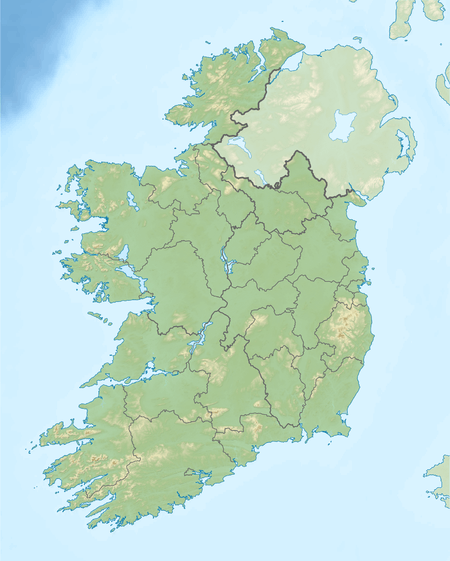Ballynavenooragh
| Ballynavenooragh | |
|---|---|
|
Native name Irish: Baile na bhFionnúrach | |
 Location of Ballynavenooragh in Ireland | |
| Type | stone ringfort with clocháns and souterrain |
| Etymology | Irish: "settlement of the white hills"[1] |
| Location | Ballynavenooragh, Dingle Peninsula, County Kerry |
| Coordinates | 52°13′34″N 10°17′53″W / 52.226155°N 10.297978°WCoordinates: 52°13′34″N 10°17′53″W / 52.226155°N 10.297978°W |
| Built | 7th–10th centuries AD |
| Owner | state |
| Official name: Cathair na BhFionnúrach Stone fort, huts & souterrain; Ballynavenooragh Stone fort & hut | |
| Reference no. | 221.0712 |
Ballynavenooragh (/ˌbælɪnəmˈjuːrə(x)/) (Irish: Cathair na bhFionnúrach)[2] is a stone fort and National Monument located in County Kerry, Ireland.[3]
Location
Ballynavenooragh lies on the Dingle Peninsula, 10 km (6.2 mi) north of Dingle town, on the western slopes of Mount Brandon. The broader Ballynavenooragh group comprises 40 ringforts, 24 clocháns and 2 cillíní.[4]
History
This cashel (stone fort, 27 metres (89 ft) internal diameter[5]) was in use in the 7th–10th centuries, with later reuse in the 13th century.[6] It is similar to the cashel at Leacanabuaile.[7]
It was excavated by Erin Gibbons in the late 1990s. A pit containing organic remains was found — apple, blackberry, hazelnut and grape seeds. Also found were stone tools, pottery, iron knives, a blue glass bead, crucible fragments, two 13th-century coins (silver pennies of Henry III)[8] and two lathe-turned objects.[2] Alder and willow were used for posts, apparently due to a lack of oak in the region.[9]
Structures
The cashel contains two clocháns, a fireplace, souterrain and several postholes, and stepped terracing. The gateposts are formed by upright slabs.[10] An oblong chamber in the souterrain is 5.5 metres (18 ft) long.[11]
References
- ↑ "Baile na bhFionnúrach/Ballynavenooragh". Logainm.ie.
- 1 2 GoKerry.ie. "Cathair na bhFionnúrach / Ballynavenooragh Stone Fort, This cashel or stone fort, National Monument, - Go Kerry". www.gokerry.ie. Retrieved 2018-07-20.
- ↑ Academy, Royal Irish (2 July 2018). "The Transactions of the Royal Irish Academy" – via Google Books.
- ↑ "The Transactions of the Royal Irish Academy". 2 July 2018 – via Google Books.
- ↑ Ireland, Royal Society of Antiquaries of (2 July 1898). "Journal" – via Google Books.
- ↑ Mytum, H. C. (2 July 1992). "The Origins of Early Christian Ireland". Routledge – via Google Books.
- ↑ Norman, E. R.; Joseph, J. K. S. St; Joseph, John Kenneth Sinclair Saint (2 July 1969). "The Early Development of Irish Society: The Evidence of Aerial Photography". CUP Archive – via Google Books.
- ↑ https://aran.library.nuigalway.ie/bitstream/handle/10379/454/MED_08.pdf?sequence=1&isAllowed=y
- ↑ Moody, Theodore William; Cróinín, Dáibhí Ó; Martin, Francis X.; Byrne, Francis John; Cosgrove, Art (2 July 1976). "A New History of Ireland: Prehistoric and early Ireland". Oxford University Press – via Google Books.
- ↑ Westropp, T. J. (2 July 2018). "The Ancient Forts of Ireland". Рипол Классик – via Google Books.
- ↑ Clinton, Mark (2 July 2018). "The Souterrains of Ireland". Wordwell – via Google Books.